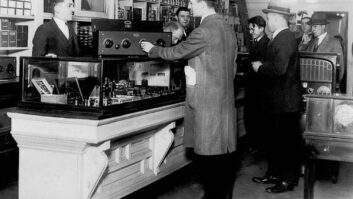Bill Frahm handles engineering for Citadel in Boise, Idaho. After reading several of Buc Fitch’s Marti tips here, he offers a couple of his own.
Bill says he has always hated that red LED for “squelch open” on the Martis; he’s been replacing them with green LEDs. Now he can tell at a glance that the Marti is up and running.
He has found that the Marti transmitters seem to have more problems when the 22MFD, +12 VDC bypass caps on the IPS/PA board get old and leaky. After replacement, things settle down. This is a good reminder for all power supply filter caps, too. A good rule of thumb is five to seven years of life. Stock up on replacement caps; you eventually will need them for all sorts of equipment.
After tuning for least trees in the RF forest, Bill runs the power adjust up and down. If the RF output stays clean during this test, he finds the unit will be more stable.
Another trick is to run the transmitter into a “tuned” whip and see if the unit spurs when the load changes.

Fig. 1: A new tower site, but can you spot the problems? * * *
It’s common during construction to let safety slide. It’s not intentional; there’s just so much to do.
Fig. 1 is a case in point. It is contributed by John Ramsey, who was called to this site.
A nice, new AM installation; looks great, right? What’s wrong with this picture?
I know: “Where’s the fence?” Remember, even during construction, climbing protection is required.
But the fence is not all that’s missing. Study the photo and read on for more answers.
* * *
Besides being a contract broadcast engineer, Nick Markowitz Jr. is an electrical and fire/security contractor, proprietor of Markowitz Electric Protection. He added observations about our “spot the problem” picture in the Feb. 10 Workbench, shown again in Fig. 2.
There is a spiral wrapped cable, commonly called BX cable, coming from the box, which is not properly secured to NEC70 standards. The box looks like it has more than one power source feeding it. If this is the case, the switches need to be clearly marked as to what they are serving and if more than one energy source is involved.
The other cable or air line floating around should be secured properly to prevent it from being snagged.
Also, Nick says that all electrical switch gear is now required to have arc fault flash ratings. OSHA requires an appropriate level of gear required to work on energized systems safely. Be aware: Nick sees a lot of new regulations creeping into the broadcast industry.

Fig. 2: Note the spiral wrapped cable coming from the box. * * *
Steve Callahan is the director of engineering for Rhode Island Public Radio. He stumbled onto this cheap and quick little fix and thought it might be helpful to someone else.
WRNI is an NPR station. During their on-air fundraising campaigns things in the studio can get hectic. WRNI uses an Audio-Technica AT808G gooseneck mic as part of their intercom/IFB system.
You’ve probably seen this model of black microphone on podiums. The IFB is important for communication with the on-air talent, but the AT808G turned up dead one morning in the middle of fundraising.
After making sure that the problem wasn’t in the wiring in the “flex” portion of the microphone’s gooseneck, Steve discovered that the problem was an open coil in the microphone element. He couldn’t wait for a replacement part, or a replacement AT808G, so he located a pair of ear bud earpieces from his junk box. He found a set of “buds” with a speaker element the same size as the mic element in the AT808G.
With a sharp blade and a quick solder job, Steve swapped the ear bud element for the dead mic element and the IFB was back in service in 10 minutes. Since the AT808G is used exclusively for IFB, the quality was equivalent, and the fundraising campaign went on with no more technical hitches.
Quick thinking Steve. Another example of where engineering saves the day.
* * *
There’s nothing like a new site, but don’t let a construction project cause you to forget about necessities.
You’ve noticed there is no fence in Fig. 1; but did you also note that there was no surge loop in the pipe connecting the ATU to the tower?
And here’s one that you may have missed: no expansion loop in the radials, where the ground radials attach to the base of the tower strap, at lower right foreground.
One would hope that the base would be covered with landscaping fabric or heavy black plastic and a layer of crushed stone. Weeds growing up between closely space radials can cause detachment when pulled.
Did you find more? Let me know. E-mail your suggestions to [email protected].
John Ramsey handles engineering for Marlin Broadcasting and other contract clients.
John Bisset marked his 40th year in broadcasting recently. He is international sales manager for Europe and Southern Africa for Nautel and a past recipient of the SBE’s Educator of the Year Award. Reach him at[email protected]. Faxed submissions can be sent to (603) 472-4944.
Submissions for this column are encouraged and qualify for SBE recertification credit.












